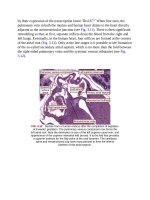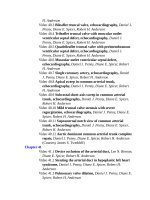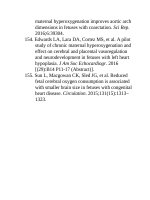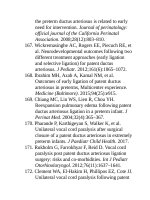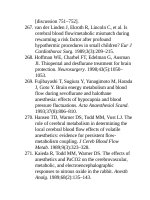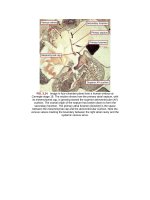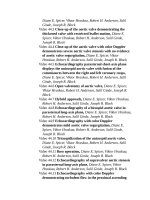Andersons pediatric cardiology 1113
Bạn đang xem bản rút gọn của tài liệu. Xem và tải ngay bản đầy đủ của tài liệu tại đây (83.9 KB, 3 trang )
pulmonaryvalvestenosisissupportedbyastudybyRomeihandcolleagues,
whoreportedasignificantlyincreasedstrokevolumeandcardiacoutputduring
cardiopulmonaryexerciseanddobutaminestresstestingin11adultswith
untreatedmildtomoderatepulmonaryvalvestenosis.22Thisisdifferentfrom
patientswhoweretreatedlateforseverepulmonaryvalvestenosis,inwhom
theremaybeapersistentimpairmentintheabilitytoincreaserightventricular
strokevolume.22
Inpatientswithmoreseverepulmonarystenosis,theonsetofsymptomsmay
stillbedelayedintolatechildhoodorearlyadultlife.Inasmallproportionof
patientswithpulmonarystenosisandanatrialcommunication,centralcyanosis
canbepresent,especiallywithexercise.Thisisalatephysicalsignbecausethe
atrial-levelright-to-leftshuntingdependsonthediastolicpropertiesoftheright
ventricle.Withsevererightventricularhypertrophyandpoorrightventricular
diastoliccompliance,thepassageofunoxygenatedbloodacrossaninteratrial
communicationintotheleftatriumisfacilitated.Inadditiontocentralcyanosis
inthepresenceofaright-to-leftshuntacrossanintraatrialcommunication,
patientswithmoderatetoseverepulmonarystenosismayalsodevelopperipheral
cyanosisduringexercise,inparticularwithanintactatrialseptum.Thisisrelated
toalimitationoftherightventricletoincreaseitsstrokevolumeandcardiac
output,resultinginanincreasedperipheraltissueoxygenextraction.Reported
symptomsincludeexerciseintoleranceanddyspnea.Chestpainofanischemic
nature―possiblyduetosubendocardialischemiaoftherightventricle,syncope,
andseveredyspneaonminimalexertion―isalatefindingandshouldprompt
rapidintervention.
PhysicalExamination
ThephysicalexaminationfindingsaresummarizedinTable42.1.Dependingon
thedegreeofstenosis,theremaybeathrillatthesecondleftintercostalspace.
Thisisnotfeltoverthecarotidarteries,thusdifferentiatingthecauseofthethrill
fromaorticstenosis.Palpatingforathrillinthesuprasternalnotchshouldbe
avoided,sincethrillsherecanbeduetoeitheraorticorpulmonarystenosis.
Table42.1
PhysicalSignsThatCanBeElicitedinValvarPulmonaryStenosis
SeverityofPulmonaryStenosis
PhysicalSign
Cyanosis
Jugularvenouspulse
Precordialthrill
Rightventricularheave
Systolicejectionclick
Ejectionsystolic
murmur
Secondheartsound
Mild
Absent
Normal
Absent
Absent
Present
Midsystolic,
ejection
Normal
Moderate
Absent
Normal
Probable
Probable
Expiratory
Longejection
systolic
Wide,variable
Severe
Possible,ifinteratrialseptaldefect
Possiblyelevated,prominenta-wave
Pronounced
Pronounced
Probablyabsent
Long,ejectionsystolic,pastaorticclosure
sound
Absentpulmonaryclosuresound
Widenedsplittingofthesecondheartsoundandanejectionsystolicmurmur
ismaximallyheardhere,withradiationintotheback.Thedelayedclosureofthe
valvarleafletscausesthewidenedsplitting.Thisisnotduetoelectrical
prolongationofsystolebutrathertocontinuedflowthroughthepulmonaryvalve
evenafterrightventricularpressureshavefallentolevelsthatwouldusually
haveresultedinvalvarclosure.Thisislikelytobeaventriculoarterial
interaction,favoredbynormalorincreasedimpedanceofthepulmonary
vascularbed.Itcanbetermed“pulmonaryhangout.”Themoreseverethedegree
ofstenosis,thewiderthesplittingofthesecondheartsound.
Astheseverityofpulmonaryvalvestenosisprogresses,themobilityofthe
valvarleafletsisoftenreduced,therebyalsoleadingtoareducedintensityofP2.
Furthermore,theejectionsystolicmurmurmaycontinuebeyondtheaortic
componentofthesecondheartsound,makingitmoredifficulttoappreciateA2.
Hencethefindingofasinglesecondheartsoundiscommoninpatientswith
moreseverepulmonaryvalvestenosis.
Inmostcasesofvalvarpulmonarystenosis,asystolicejectionclickprecedes
theonsetofthesystolicmurmur.Theclickisusuallyheardloudestseparatefrom
theareaofmaximalintensityofthecardiacmurmur,nearertheapex,oratthe
leftlowersternaledge.Thesystolicejectionclickoriginatesfromtherapid
decelerationofthepulmonaryvalvarmechanism,asthefusionalongtheirzones
ofappositionpreventsthevalvarleafletsfromreachingtheirintendedpositions
againstthewallsofthevalvarsinuses.Presenceoftheclickalsodependsonthe
timingofopeningofthepulmonaryvalve.Inmilddisease,withoutright
ventricularhypertrophy,thepulmonaryvalveopensinventricularsystolewith
theemissionofanejectionclick.Inseveredisease,withrightventricular
hypertrophyandimpaireddiastoliccompliance,thevalveopensinatrialsystole,
withouttherapiddecelerationcausedbyventricularsystole.Thusnoclickis
heard.Inmoderatepulmonarystenosis,inspirationaugmentssystemicvenous
flowandatrialfilling.Theaugmentedatrialpressureallowsatrialsystoleto
openthepulmonaryvalve.Hencethesystolicejectionclickisheardonlyin
expiration.Insomepatientswithpulmonarystenosisandtricuspidregurgitation,
therightventricularpressureishighenoughtocauseapansystolicmurmurat
theleftlowersternaledge,relatedmoretothedegreeoftricuspidregurgitation
thantothevalvarstenosisitself.
Thephysicalfindingsinpatientswithsupravalvarstenosisaresimilarexcept
fortheabsenceoftheejectionclick.Stenosisfurtheroutintothepulmonary
arterialtreecanbeheardaslongsystolicorcontinuousmurmursintheaxillaeor
overthelungfieldsattheback.Carefulgeneralphenotypicassessmentmay
showthesignsorsyndromicdiagnosis,asseeninNoonan,Alagille,orWilliams
syndrome.
BasicInvestigations
Basicinvestigationsaredirectedtowardassessingtheeffectsandseverityofthe
pulmonarystenosis.
Electrocardiogram
Themostpertinentelectrocardiographic(ECG)findingsaresummarizedin
Table42.2.ECGmaybenormal,itmayrevealthedegreeofrightventricular
hypertrophy,or,indeed,itmaypointtorightatrialenlargement,whichwillbe
seenonlyinthemoreseverecases.TherearenofeaturesoftheECGthatare
uniquetovalvarpulmonarystenosis,althoughtheseverityofstenosisis
reflectedinthedegreeofrightventricularhypertrophyandstrain.Afullright
bundle-branch-blockpatternisrare,butanRSR′patterncanbeseenandreflects
alesserdegreeofrightventricularhypertrophythantheequivalentexclusiveRwavecomplexinV1.23,24
Table42.2
SeverityofPulmonaryStenosis
Electricalaxis
R:Sratio
V1Ramplitude
Rightatrialenlargement
Mild
Normal
Normal
Normal
Normal
Moderate
90–130
upto4:1inV1
10–20mV
Possible
Severe
110–150
Alsoinvertedinleftleads
>28mV
Present
TheuseofECGfindingstoestimatetheseverityofpulmonaryvalvestenosis
